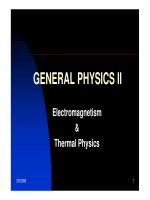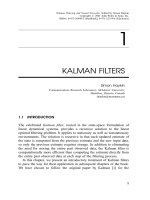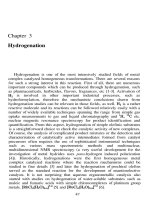Chapter 3: Experimental Errors doc
Bạn đang xem bản rút gọn của tài liệu. Xem và tải ngay bản đầy đủ của tài liệu tại đây (1.91 MB, 67 trang )
Chapter 3: Experimental Errors
Chapter 4: Statistics
Steps in a Typical Quantitative Analysis
¾Data of unknown quality are useless!
¾All laboratory measurements contain
experimental error.
¾It is necessary to determine the magnitude of
the accuracy and reliability in your measurements.
¾Then you can make a judgment
about their
usefulness.
Replicates - two or more determinations on the same sample
Example 3-1: One student measures Fe (III) concentrations six times.
The results are listed below:
19.4, 19.5, 19. 6, 19.8, 20.1, 20.3 ppm (parts per million)
6 replicates = 6 measurements
The "middle" or "central" value for a group of results:
¾ Mean: average or arithmetic mean
¾ Median: the middle value of replicate data
¾ If an odd number of replicates, the middle value of replicate data
¾ If an even number of replicates, the middle two values are averaged to
obtain the median
N
N
1i
i
∑
=
=
x
x
Terms & Definitions
Example 3-2: measurements of Fe (III) concentrations:
19.4, 19.5, 19. 6, 19.8, 20.1, 20.3 ppm (parts per million)
What are the mean and median of these measurements
Mean =
= 19.78 ppm = 19.8 ppm
6 replicates
An even number of replicates !!!
Median =
= 19.7 ppm
Calculation: Mean and Median
6
20.320.119.819.619.519.4 +++++
2
19.819.6 +
Calculation: Mean and Median
Example 3-3: measurements of Fe (III) concentrations:
19.4, 19.5, 19. 6, 19.8, 20.1 ppm (parts per million)
What are the mean and median of these measurements
Mean =
= 19.68 ppm = 19.7 ppm
5 replicates
An odd number of replicates !!!
Median = 19.6 ppm
5
20.119.819.619.519.4 ++++
Any Questions???
¾ Precision - describes the reproducibility of measurements.
How close are results which have been obtained in
exactly the same way?
The reproducibility is derived from the deviation from the
mean:
Deviation from the mean = d
i
= |x
i
-|
¾ Standard deviation
¾ Variance
¾ Coefficient of variation
Terms & Definitions
X
¾ Accuracy - the closeness of the measurement to the
true or accepted value.
This "closeness" called as the error:
absolute or relative error of a result to its true value.
Terms & Definitions
¾absolute error
¾relative error
¾ Outlier - Occasional error that obviously differs
significantly from the rest of the results.
Terms & Definitions
Precision & Accuracy
Mean & True Value
Mean :
X
X
t
= true value
Absolute and Relative Errors
¾ Absolute Error (E) - the difference between the experimental
value and the true value. Has a sign
and experimental units:
Experimental value – true (acceptable) value
¾Relative Error (E
r
) - the absolute error corrected for the size of the
measurement or expressed as the fraction, %, or parts-per-thousand (ppt)
of the true value. E
r
has a sign, but no units.
parts per hundred (pph) = E
r
x100
parts per thousand (ppt) = E
r
x1000
100%x
t
ti
r
E
x
xx −
=
ti
E xx −=
Calculation: Absolute and Relative Errors
Example 3-4: measurements of Fe concentrations:
19.4, 19.5, 19. 6, 19.8, 20.1, 20.3 ppm
Assumed we already knew the true value of Fe (III) concentration at 20.0-
ppm. What are
absolute and relative errors of each
measurement?
E = 19.4 - 20.0 = -0.6 ppm Er =(-0.6/20)x100% = - 3%
E = 19.5 - 20.0 = -0.5 ppm Er =(-0.5/20) x100%= -2.5% ~ -3%
E = 19.6 - 20.0 = -0.4 ppm Er =(-0.4/20) x100% = -2%
E = 19.8 - 20.0 = -0.2 ppm Er =(-0.2/20) x100% = -1%
E = 20.1 - 20.0 = 0.1 ppm Er=(0.1/20)x100% = 0.5%
E = 20.3 - 20.0 = 0.3 ppm Er = (0.3/20)x100% =1.5% ~ 2%
A method of analysis yields weights for gold that are low
by 0.3 mg. Calculate the percent relative error caused by
this uncertainty if the weight of gold in the sample is
(a) 800 mg; (b) 500 mg; (c) 100 mg; (d) 25 mg
E = -0.3 mg
100%x
t
ti
r
E
x
xx −
=
ti
E xx −=
Er = (-0.3 mg/500 mg) x100% = -0.06% = -0.06 pph
= -0.6 ppt
Example 3-5
Any Questions???
¾ Systematic or determinate errors
affect accuracy!
¾ Random or indeterminate errors
affect precision!
¾ Gross errors or blunders
Lead to outlier’s and require statistical techniques
to be rejected.
Types of Errors
1. Instrument errors - failure to calibrate, degradation of parts
in the instrument, power fluctuations, etc.
2.
Method errors - errors due to no ideal physical or chemical
behavior - completeness and speed of reaction, interfering side
reactions, sampling problems
3.
Personal errors - occur where measurements require
judgment, result from prejudice, color acuity problems
Systematic or Determinate Errors
Systematic or determinate errors
¾ Potential Instrument Errors
¾Variation in temperature
¾Contamination of the equipment
¾Power fluctuations
¾Component failure
All of these can be corrected by calibration
or proper instrumentation maintenance.
Systematic or determinate errors
¾ Method Errors
¾Slow or incomplete reactions
¾Unstable species
¾Nonspecific reagents
¾Side reactions
These can be corrected with proper
method development.
Systematic or determinate errors
¾Personal Errors
¾Misreading of data
¾Improper calibration
¾Poor technique/sample preparation
¾Personal bias
¾Improper calculation of results
These are blunders that can be minimized or
eliminated with
proper training and experience.
The Effect of Systematic Error - normally "biased"
and often very "reproducible".
1. Constant errors -E
s
is of the same magnitude, regardless of
the size of the measurement.
This error can be minimized when larger samples are used. In other
words, the relative error decreases with increasing amount of analyte.
Er = (Es/X
t
)x100%
Constant
eg. Solubility loss in gravimetric analysis
eg. Reading a buret
2. Proportional errors -E
s
increases or decreases with
increasing or decreasing sample size, respectively. In other words, the
relative error remains constant.
Proportional
Typically a contaminant or interference in the sample
Detection of Systematic Method Errors
1. Analysis of standard samples
2. Independent Analysis: Analysis using a "Reference
Method" or "Reference Lab"
3. Blank determinations
4. Variation in sample size: detects constant error only
Gross Error
¾Gross errors cause an experimental value to be discarded.
¾ Lead to outlier’s and require statistical techniques to be
rejected.
¾Examples of gross error are an obviously "overrun end point"
(titration), instrument breakdown, loss of a crucial sample, and
discovery that a "pure" reagent was actually contaminated.
¾We do NOT use data obtained when gross error has
occurred during collection.
Random Errors
¾ caused by uncontrollable variables which normally cannot
be defined
¾The accumulated effect causes replicate measurements to
fluctuate randomly around the mean.
¾ Random errors give rise to a normal or gaussian curve.
¾ Results can be evaluated using statistics
¾ Usually statistical analysis assumes a normal distribution









